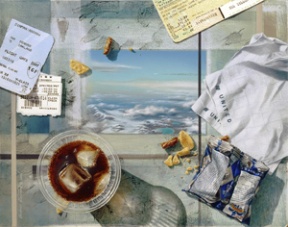New Gallery Fraga show highlights eight artists working in the trompe l’oeil style.
Andrew Denman pays extraordinary attention to the ordinary.
For Gallery Fraga’s current exhibit, Denman and seven other artist painstakingly render everyday objects, working in the hyper-real trompe l’oeil (fool the eye) tradition.
Denman’s interest in trompe l’oeil was piqued when a fifth grade teacher showed the class works by 19th century trompe l’oeil painters John Frederick Peto, John Haberle and William Harnett.
“We’re used to paintings of famous people, paintings of religious scenes, paintings of historical scenes,” Denman said. “But here were artists who found a half-peeled orange to be a subject of great elegance.”
The technical prowess of the trompe l’oeil painters inspired awe and even disbelief among early viewers, some of whom tried to peel from the canvases what they were convinced were photographs pasted on.
Harnett and Haberle’s paintings of currency got the men arrested for counterfeiting.
Denman most often paints wildlife, but the current show displays still life paintings. Like many trompe l’oeil works, they are small in scale.
“Oceana III” contains a rendering of a photograph of Bodega Bay, and features crabs and shells Denman collected there. Denman’s diptych featuring a pair of roses is, he says, a tribute to the botanical art of the 19th century.
His “Air Travel” is the exception, with its accoutrements of flying on an airplane.
Arguably the most successful of the five pieces representing his work in the current show, “Air Travel” has a frame-within-a-frame – a cut-out and finely finished masonite square that invokes a window through which the viewer sees an aerial view of geological formations.
Denman makes the conventional pictorial space ambiguous by scattering the detritus of air travel – crumpled napkins, stubs of boarding pass, empty bag of peanuts – across the picture plane.
Cast shadows further contradict the spatial relationship implied by portal and window.
It’s an effective ploy that underscores one of the most interesting features of the genre: the simultaneous presentation of two versions of pictorial “space,” a question that emerged as central for early Modernists and, in various guises, for much art of the 20th century.
Denman is keenly aware of the issue.
“The history of art from the late 1800s is basically a struggle between treating the substrate as a space that creates the illusion of depth, or as a flat surface to be decorated,” he said. “I think the trompe l’oeil painters were much more modern than people gave them credit for.
“Because there’s always a shallow depth of field in trompe l’oeil paintings that acknowledges a surface. If you’re painting wood grain, you’re drawing attention to the surface. But it’s also illusionist space that you can enter.”
Denman’s own work adds one more layer of complexity, because each painting contains both hyper-real and abstract elements.
Denman begins by laying on paint with a palette knife, letting the nature of the material form the abstract pattern. Then he places the objects he will paint onto the background and takes the photograph he will use as a reference to paint.
He works on several pieces at various stages, so he can trade off one way of working with the other.
“For me, the interplay between richly abstract and clearly representational is more evocative than either one by itself,” he said. “The challenge is how to bridge the gap – how to move between those distinct styles.”
The esthetic problem is an advanced one; it takes skill and intuition to blend elements that are so disparate into a cohesive work of art. But Denman pulls it off admirably.
“For me, the dialogue between where I let go and where I assert control is just what I need,” Denman said. “It’s very important to me.”
*****************
The eyes have it
“The Best of Trompe l’Oeil Today,” a show of hyper-real “fool the eye” paintings, is on view through August at Gallery Fraga and features works by artists nationwide, including Larry Charles, Lorena Kloosterboer, Becky Bening, Donald Clapper, Debra Torres, Michael Molnar, Andrew Denman and Robert Kirkpatrick. For more information, visit www.galleryfraga.com or call 842-1150.



